Custom Gaskets
EMI Gaskets
Die cut and custom molded EMI gaskets for environmental sealing, thermal insulation, and shelding against electromagnetic interference (EMI)
Die cut and custom molded EMI gaskets for environmental sealing, thermal insulation, and shelding against electromagnetic interference (EMI)

Stockwell Elastomerics also makes combination silicone sponge – wire mesh EMI shielding gaskets.
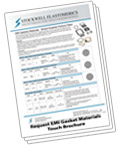
Includes small samples of EMI gasket materials to touch and feel.
EMI gaskets that are made of electrically conductive elastomers such as silicone or fluorosilicone provide environment sealing, thermal insulation, and shielding against electromagnetic interference (EMI). They support a variety of fabrication methods, are available in materials that meet tough standards, and can be supplied with conductive adhesive backings for ease-of-installation. There are many types of EMI shielding materials, but electrically conductive silicones provide gasket designers with performance and versatility.
Specifically, EMI gaskets seal the gap between two mating surfaces. Like other types of environmental gaskets, they seal out the external environment or seal-in to prevent leakage. What makes EMI gaskets different is that they also seal against conducted or radiated EMI that can interfere with circuits. When this electromagnetic interference “noise” reaches the EMI gasket, the signals are negated and the resulting electrical current is sent to ground. Silicone is normally an electrical insulator rather than an electrical conductor, but the addition of metal or metal-coated particles imparts the necessary electrical conductivity.
Stockwell Elastomerics offers manufacturing for all of these types of EMI/RFI shielding gaskets:
More about how EMI gaskets are made is provided below.
The ever growing wireless and electronics markets have increased the stakes for managing electromagnetic interference (EMI) and radio frequency interference (RFI). This holds true for consumer, commercial/industrial markets as well as military applications. Managing EMI is required of electronic device manufactures under Title 47 of the Federal Code of Regulation and Mil-DTL-461. These are some leading EMI standards and their applications:
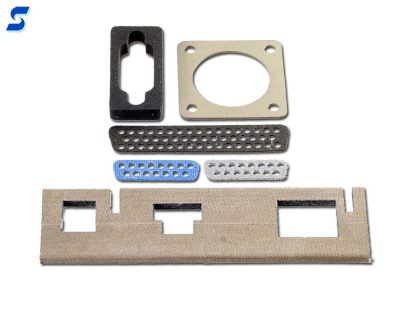
Radiant EMI is often emitted by unintended antennas, meaning that internal wires and components can act as emitting antennas. A common practice to manage EMI radiation and EMI susceptibility is to completely encase electronics in a conductive enclosure. This usually entails a housing, lid, and a conductive gasket; it’s critical that the lid and enclosure have complete contact all the way around, hence a conductive gasket. Stockwell Elastomerics manufactures EMI gaskets for Class A (typically industrial), Class B (typically residential), and military applications. EMI gaskets manufactured by Stockwell Elastomerics regularly perform EMI attenuation as well as environmental sealing (rain, dust, wash down, etc.)
Stockwell Elastomerics manufactures custom EMI shielding gaskets made from various electrically conductive rubber (also called conductive silicone) materials. These particle filled silicone or particle filled fluorosilicone EMI/RFI gaskets are typically thinner, .010″ – .062″ thick with full, XYZ axis conductivity and with proper compression can pass IP67 or NEMA type 6, submersion tests in addition to EMI shielding.
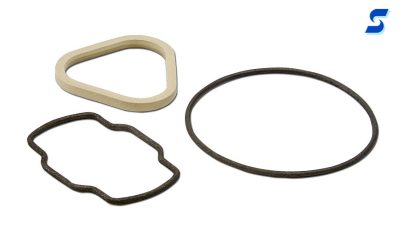
Nickel / graphite filled silicone gasket materials are predominantly specified for industrial, commercial and residential applications because of their good attenuation, strong sealing properties and low cost. Most commercial EMI gasket applications can be satisfied with Ni/C products. Larger enclosures may require thicker and softer EMI gaskets (see Combination Silicone Sponge and Wire Mesh EMI Shielding Gaskets).
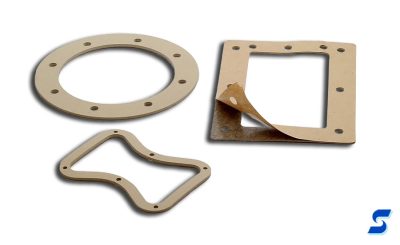
Mil-STD-461 is the global specification related to EMI for equipment and subsystems. MIL-DTL-83528 is the specification for filled EMI gaskets. This requirement is very concise – if a print calls for a MIL-DTL-83528 Type X gasket, the polymer, fill, attenuation, and mechanical properties are specified. The most common military / aerospace EMI gaskets often call for silver coated aluminum to meet MIL-DTL-83528 specifications. Military or aerospace applications may also use fluorosilicone instead of silicone for its fuel and chemical resistance.
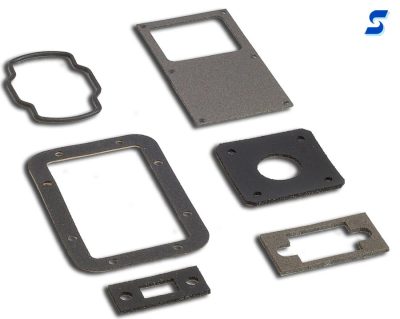
In-house water jet cutting and stock materials allow Stockwell Elastomerics to quickly supply production and prototype EMI gaskets. 2D EMI gaskets may be prototyped on Stockwell Elastomerics’ waterjet cutting machines and then moved to molding or production parts, all using the same EMI compound.
Stockwell Elastomerics compression molds conductive silicone and fluorosilicone rubber compounds in its custom molding facility. Molding the EMI gasket allows the designer to add sealing ribs and other performance enhancing features to optimize environmental sealing and EMI shielding properties. Stockwell Elastomerics has a broad range of compounds that meet MIL-DTL-83528 classifications for electrically conductive EMI shielding gaskets.
Stockwell Elastomerics manufactures custom combination EMI gaskets from expanded silicone or fluorosilicone sponge and have knitted wire mesh bonded to the edge (see picture at right). Combination gaskets are usually thicker and softer than conductive rubber EMI gaskets. This thicker and softer quality allows for more compression under lower clamping pressure, providing enclosure sealing with wider tolerance stacks.
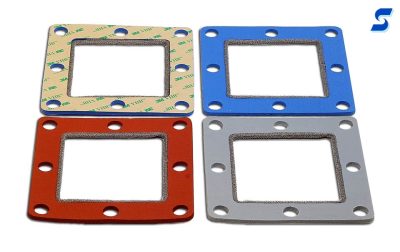 Combination EMI gaskets are often used for large NEMA enclosures or other enclosures with limited clamping forces or sheet metal skins. Since silicone sponge or foam is very compliant under low clamping force, they “absorb” mating variation (flatness tolerances) between sealing faces creating a water seal for outdoor environments; the knitted mesh electrically bonds the metal faces. Note: bare metal or conductive chem-films are required at the mesh point of contact to facilitate a conductive path.
Combination EMI gaskets are often used for large NEMA enclosures or other enclosures with limited clamping forces or sheet metal skins. Since silicone sponge or foam is very compliant under low clamping force, they “absorb” mating variation (flatness tolerances) between sealing faces creating a water seal for outdoor environments; the knitted mesh electrically bonds the metal faces. Note: bare metal or conductive chem-films are required at the mesh point of contact to facilitate a conductive path.
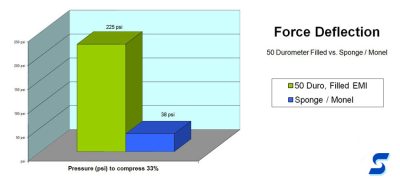 Combination EMI / RFI gaskets are most commonly manufactured in 0.125″ (3.18mm) and 0.25″ (6.4mm) though other thickness options are available upon request. Knitted Monel wire mesh is used for its corrosion resistance.
Combination EMI / RFI gaskets are most commonly manufactured in 0.125″ (3.18mm) and 0.25″ (6.4mm) though other thickness options are available upon request. Knitted Monel wire mesh is used for its corrosion resistance.
 UL 50E and UL 94V-0 rated silicone foams are often used for the water or dust sealing function of the combination gasket. While the combination EMI gasket configuration has not been tested by UL, the silicone foams have been. This third party test adds confidence that a third party, pre-qualified gasket material is used.
UL 50E and UL 94V-0 rated silicone foams are often used for the water or dust sealing function of the combination gasket. While the combination EMI gasket configuration has not been tested by UL, the silicone foams have been. This third party test adds confidence that a third party, pre-qualified gasket material is used.
Silicone foam has excellent UV and ozone resistance and long term rebound (compression set resistance), making it a good choice for outdoor EMI enclosure gaskets. Closed cell silicone foams are used when water sealing is needed, open cell silicone foams are used for dust sealing applications.
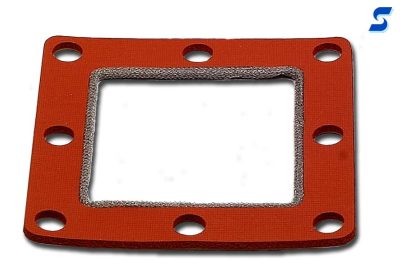
Closed cell silicone sponge materials are better suited for rugged enclosures or enclosures where the gasket is not protected from a jet blast (IP66 or NEMA 4). The gum based silicone sponge materials are tougher and more closed cell than liquid based silicone foams, so they are specified more often for rugged or outdoor EMI combinations gaskets.
Combination EMI / RFI gaskets using silicone sponge are available in soft, medium and firm grades that are widely used for military enclosures and remote location applications where environmental conditions can vary greatly, from sub-freezing temperatures to arid desert conditions. Knitted Monel wire mesh is bonded to the opposite side of the environmental conditions (typically the interior of the window gasket), protecting the metal mesh from the elements.
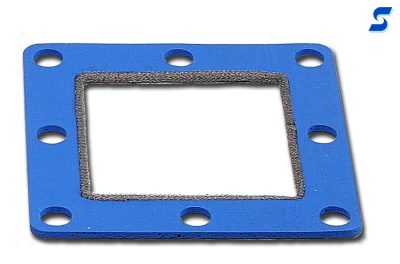
Military and Aerospace applications may require chemical resistance in addition to EMI shielding and environmental sealing; for these applications Stockwell Elastomerics manufactures EMI combination gaskets using R10490 closed cell fluorosilicone sponge. Fluorosilicone shares many of the same properties as silicone, such as high temperature and low temperature resistance, but with enhanced chemical resistance. Fluorosilicone is typically only specified where chemical resistance is needed due to the price premium.
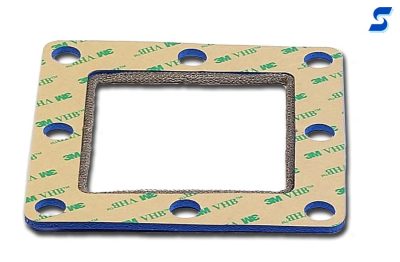
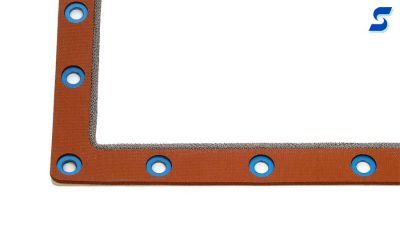
Stockwell Elastomerics offers combination EMI / RFI gaskets with compression stops, sometimes called compression limiters, to protect the gasket from being crushed under torque. Since gasket materials relax they are very difficult to set torques, the use of compression stops allow assemblers to use torque specifications since fasteners will seat on the metal hard stop.
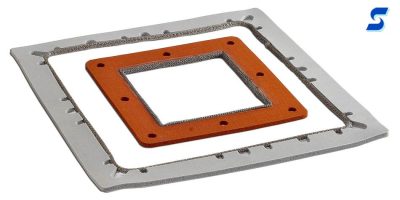 Large EMI gaskets for electrical enclosures and cabinets are often addressed using a corrosion resistant Monel wire mesh bonded to a closed cell silicone sponge. The wire mesh / sponge gasket allows for greater tolerances between sealing faces. The sponge and wire mesh offer forgiving, low closure forces to prevent sheet metal bowing between latches or fasteners.
Large EMI gaskets for electrical enclosures and cabinets are often addressed using a corrosion resistant Monel wire mesh bonded to a closed cell silicone sponge. The wire mesh / sponge gasket allows for greater tolerances between sealing faces. The sponge and wire mesh offer forgiving, low closure forces to prevent sheet metal bowing between latches or fasteners.
EMI silicone gaskets can be fabricated using waterjet cutting, die cutting, or compression molding.
EMI gaskets that are not fabricated as a single piece can be joined using cold bonding or hot splicing.
EMI (electromagnetic interference) and RFI (radio frequency interference) are often used interchangeably. Both are electrical disturbances/electromagnetic emissions that can cause problems in some equipment. The simple difference between EMI and RFI is that EMI includes any electrical frequency, while RFI is limited to the radio frequency spectrum, which is a subset of the entire electrical noise spectrum. So EMI gaskets and RFI gaskets basically do the same function.
Contact Us for further assistance with EMI gaskets, EMI shielding gaskets, RFI gaskets, military EMI gaskets, combination silicone sponge – wire mesh EMI shielding gaskets, waterjet cut and molded EMI gaskets.